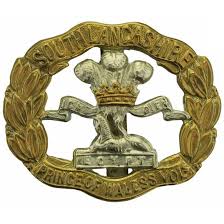Personal Details
Born: 27 January 1881 in Prees, Shropshire and baptised on 27 February at St. Chad’s, Prees.
Family: He was the youngest of three children born to Thomas Hollands, a shoemaker, and his wife Harriet. He married Alice Crewe on 6 November 1901 in Whitchurch, Shropshire and together they had two children, Florence Alice and Dora Gertrude. Sadly Alice died in 1915. Alfred married Sarah Jane Smout in Quarter 3 1927 in the Wem Registration District.
Residence: In 1881 he was living with his parents in Peggs Row, Stoke Village, Stoke upon Tern, Market Drayton, Shropshire; by 1891 they had moved to Green End, Whitchurch and by 1901 to Paces Yard, 13 Dodington. In 1911 he was living with his wife and daughters at 14a Dodington. The address shown for his pay when he was discharged in 1919 was 49 Bridge Street, Crewe, but on the 1939 Register his address was 32 Claypit Street, Whitchurch, where he was living at the time of his death.
Employment: On the 1911 Census his occupation was given as a labourer. However by 1939 he was described as a blacksmith.
Died: In 1939 in Whitchurch, aged 58, and was buried on 20 November in Whitchurch cemetery.
Military Details
Regiment: South Lancashire Regiment
Rank: Private
Service Number: 242647
Date of Enlistment: 11 December 1915
Date of Discharge: 20 February 1919
Reason for Discharge: Demobilisation
Alfred was awarded the Campaign Medals (British War Medal, and Victory Medal).

The British War Medal (also known as 'Squeak') was a silver or bronze medal awarded to officers and men of the British and Imperial Forces who either entered a theatre of war or entered service overseas between 5th August 1914 and 11th November 1918 inclusive. This was later extended to services in Russia, Siberia and some other areas in 1919 and 1920. Approximately 6.5 million British War Medals were issued. Approximately 6.4 million of these were the silver versions of this medal. Around 110,000 of a bronze version were issued mainly to Chinese, Maltese and Indian Labour Corps. The front (obv or obverse) of the medal depicts the head of George V. The recipient's service number, rank, name and unit was impressed on the rim.
The Allied Victory Medal (also known as 'Wilfred') was issued by each of the allies. It was decided that each of the allies should each issue their own bronze victory medal with a similar design, similar equivalent wording and identical ribbon. The British medal was designed by W. McMillan. The front depicts a winged classical figure representing victory. Approximately 5.7 million victory medals were issued. Interestingly, eligibility for this medal was more restrictive and not everyone who received the British War Medal ('Squeak') also received the Victory Medal ('Wilfred'). However, in general, all recipients of 'Wilfred' also received 'Squeak' and all recipients of The 1914 Star or The 1914/1915 Star (also known as 'Pip') also received both 'Squeak' and 'Wilfred'. The recipient's service number, rank, name and unit was impressed on the rim.

